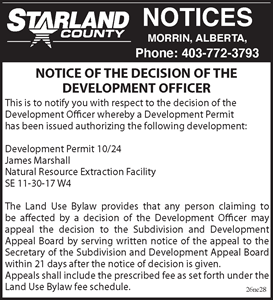
Last week an acreage owner had a unique guest, who, after invited, decided to stick around a couple days.
Tony Keller lives near Munson and last week along Township road 30-0, he spotted a small falcon-like bird that appeared to be a fledgling hawk on the road.
“I was driving down the road and he was just sitting there,” said Keller. “I slowed down because I thought he would take off and get out of the way of the car, but he hobbled down into the ditch. So I slowed down, got out, picked him up from the ditch, and made sure he wasn’t all busted up, put it in the passenger seat of the car and took him home.”
The bird was missing feathers from the top of its head and appeared to be somewhat injured.
After he took the bird home, he tried to feed it some meat and used an infant medicine syringe to give it some fluid. Tony left the bird alone to explore and it hopped up into a tree. The next morning the bird appeared to be gone.
“But I found him hiding out over by my shop,” said Keller. He brought the bird closer to his house to keep it from any wild animals in the area and called the Medicine River Wildlife Centre.
“He hobbled around and called out a few times. He could see his buddies flying around above him but nobody would come and see him,” chuckles Keller.
Keller gave him some more nourishment and the bird spent the next night in the shop and the day after, he met a staff member of the rehabilitation centre in Three Hills and handed the bird over.
Carol Kelly, executive director of the Medicine River Wildlife Centre explains the centre is a wildlife hospital with goal of rehabilitating animals and then releasing them back into the wild. It is also an education centre.
“What we do is look at the animal, identify what is wrong with it. In most cases at this time of year most injured hawks have been hit by cars, secondly electrocuted on power lines or thirdly injured by barbed wire,” Kelly said. “We’ll decide on treatment according to that and if it improves, is strong and healthy and ready to release, we’ll do that.”
She said often the animals do not stabilize and perish while they are being treated, or they are too injured to treat and are humanely put down.
Keller hopes he will cross paths with the bird again.
“If he does recover, I hope they bring him back down here. These birds are doing a pretty good job of keeping the gopher and mice away,” said Keller.
Kelly says this might not be possible.
“If it is a baby Swainson’s hawk like we believe it is, they all leave Alberta by September. By the time this one recovers from its injuries and it is strong and ready to go, hopefully it will be ready to catch the migration, and leave with Swainson’s hawks. At that point it doesn’t really matter where you release it because they are all leaving anyway.”
It’s hard to say if it will ever return.
“Whether that particular bird might migrate back to this area next year is anybody’s guess,” said Kelly. “The adults will very likely return to the same territory if they were successful there, whereas the babies can disperse.”
She said that in this case it appears the right thing for the animal was done.
“If it is clearly injured we recommend putting it into a small cardboard box, keep it dark, warm and quiet and contact the centre,” she said.
Kelly said there are cases when it is not so clear, however technology can help. With so many carrying a smart phone with a camera, a phone call and a couple of photos can help.
“Before you disturb an animal, you can talk to someone,” she said.




























